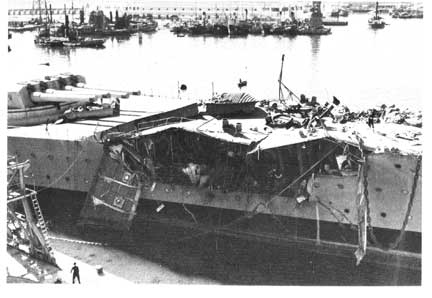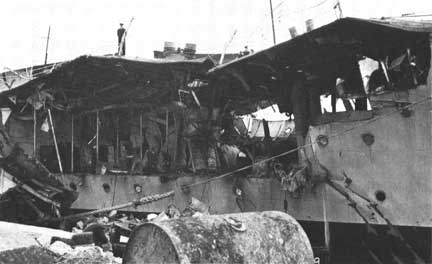 |
 |
 |
|
(Photo by Bill Wade, flying off USS Ranger) |
I am not quite sure what to think of the reports of Massachusetts' battle with the Jean Bart. Massachusetts won. Her opponent, however, was fighting while tied to a dock, with one primary turret not yet installed. While both ships were designed and built at about the same time to the same treaty considerations, France's naval program had been interrupted by the German invasion.
Still, the battle raises questions. The US ordinance department at this time was well known for ignoring problems with US torpedoes. Were they covering up similar problems with AP shells? Of the five shells that hit Jean Bart,two, perhaps three, failed to explode. The two that exploded hit in the "nothing" sections of an "all or nothing" designed battleship. These two wrecked large parts of the ship, but parts that contained no vital equipment.
The two hits which definitely did not explode hit the hard armor of the primary turrets. In both cases, the fuse mechanism broke off. In one case, the inert shell - weighing 2,700 pounds, moving at 1,520 feet per second, falling at a 25 degree angle - crippled the target even without exploding. The one operational turret was jammed in position by impact damage to the barbette. For three hours, the Jean Bart could not traverse the forward turret to bring her guns to bear on target.
The two hits on the soft zones make me wonder about "all or nothing" battleship design. Nothing vital was destroyed. The ship could still fight. The all or nothing approach puts all vital equipment in the middle of the ship, armors the middle of the ship, and saves weight by not protecting the bow or stern. The heavily protected "citadel" section amidships generally runs from just forward of the main turret, to just aft of the rear turret. In these pictures, look for the dividing line between the "all" and "nothing" sections of the ship.
 |
|
|
 |
|
|
 |
|
|
The fifth shell to hit entered the funnel, and passed easily through several light internal partitions. The first heavy deck encountered by the shell was the hull, just below the water line. As designed, the AP shell went right through this armor, and delayed for 0.033 seconds before detonating. Maybe. They were not able to determine if this shell went off. At the point it should have detonated, it was well clear of the ship and underwater. This is a strange combination of the funnel being a weakness in the protection of the citadel, and the "weakness" defeating the design of the shell. As armor piercing shells only detonate after piercing armor, they are not effective against unarmored targets. In war, one must expect the unexpected, because sure enough things will not happen as anticipated.
The large nose fragment of the stern hit also passed clean through the bottom of the hull. This caused the flooding that settled the stern of Jean Bart to the bottom of her berth.
Among the e-mails received regarding this web site, I received one from the son of a pilot who put a bomb into the Jean Bart, before Massachusetts opened fire. The Massachusetts histories of the battle fail to mention the aircraft attacks. I recently found a web site dedicated to Air Group 4, flying off the USS Ranger. Their account of the battle credits the dive bombers, but fails to mention the Massachusetts. Such is the nature of military history. :-) I would note that the Ranger's entry in the Dictionary of American Fighting Ships has AG 4 very busy off Cassablanca, but does not mention Jean Bart.
Just to complete the alleged history of the sinking of the Jean Bart, I'll add a sentence from Squadron/Signal publications' US Battleships in Action Part 1. "After a stint as a radar training ship in early 1942, New York returned to active duty in the Atlantic, participating in the destruction of Jean Bart at Casablanca in November of that year." New York's DoAFS entry confirms New York too was busy off Cassablanca, but makes no mention Jean Bart.
It is interesting to note, after all these ships destroyed Jean Bart, that after the war she was made fully operational.
 |
|
|
Jean Bart's main battery didn't score any hits on Massachusetts, but an 8 inch shore battery in the same battle did. This hit scored in Massachusetts' citadel section. The shell pierced the 1.5 inch armor of the main deck, shown above, but detonated above 5.3 inch armored deck one level down. The main deck is designed to be sufficient to trigger the fuse of an AP shell, but is not not intended to stop the shell. While the marine's bunk room was wrecked, the marines were at battle stations, no one was hurt, and no critical equipment was damaged. Even in the citadel area, the upper deck above the armor contained no battle critical gear.
 |
 |
|
|
How were they so sure that the hit from the French shore battery was from an 8 inch gun? Simple. You measure the hole in the armor. As a civilian living a fairly quite mundane life, one doesn't often encounter hardened steel twisted and torn. Massachusetts sitting at rest only begins to give a feel for the scale and violence of WW II. a few shell fragments, and the above punctured armor, tell another part of the story. Above, two sides of the same piece of metal, punctured at Casablanca.
 |
|
|
The Massachusetts was flying this flag the day she fought Jean Bart. It was hoped that the French might not fire on their World War I ally, thus an extra large flag was made ready, but note the shell hole in the lower center of the flag.
 |
|
Note the hole in the lower flag. |
 |
Shore - Dock -
Engines - Dry-dock
- Perspectives
Anchor - 16 Inch -
George - Turret 3
- Shells - Magazines
- Jean Bart - Armor
Hatches - Five
Inchers - Inside 5" - Quad
40s - Turkey Trot
AA Directors - Sky -
Spot - Radar -
Last Look - History
- BB Names
Massachusetts - Galveston
- Homepage - NavShips
& NavRing